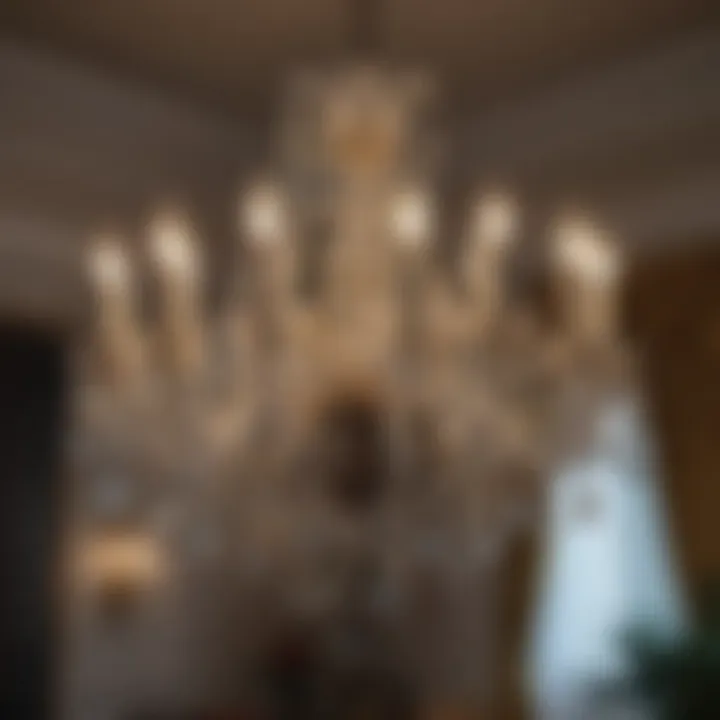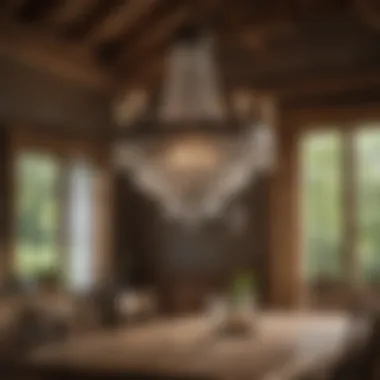Chandelier Pictures: Illuminating Home Decor Concepts


Intro
Chandeliers have long been symbols of elegance and sophistication. Their impact on a room's overall decor is undeniable. This article delves into how chandelier pictures play a pivotal role in the design of homes. By examining various styles, placement options, and the visual appeal these lights bring, homeowners can make informed choices that resonate with their personal taste. The beauty of chandeliers lies not only in their functionality but also in their ability to transform spaces into inviting environments.
Design Inspiration
When considering chandeliers, understanding current trends in interior design is essential. Contemporary homes often embrace a fusion of styles. Minimalist designs favor sleek, linear chandeliers, while more traditional spaces may opt for ornate, vintage models. A chandelier can serve as the centerpiece of a room, dictating the overall tone and feel of the space.
Current Trends in Interior Design
In today's market, several trends dominate the landscape of chandelier design:
- Industrial Influence: Exposed bulbs and metallic finishes are popular, appealing to urban aesthetics.
- Natural Materials: Wood and rattan are being embraced. These materials bring warmth and a sense of calm.
- Sculptural Designs: Chandeliers that resemble art pieces are gaining traction. They attract attention even when not lit.
- Smart Lighting: As technology grows, many chandelier designs incorporate smart bulbs that allow customization and remote control.
Color Schemes and Palette Ideas
The color of a chandelier can enhance its beauty and influence the mood of a room. Neutral tones like whites and creams are versatile, fitting seamlessly into various themes. Meanwhile, bold colors such as deep blue or emerald green can inject personality into spaces.
When considering color schemes:
- Match the chandelier to existing colors in the room.
- Use contrasting colors to create a striking visual effect.
- Remember that metallic finishes reflect light, adding depth and dimension.
End
Understanding the trends and choices available allows homeowners to select chandeliers that align with their style vision. The pictures of these stunning light fixtures not only inspire creativity but also aid in making informed decisions for ambient home design.
Prologue to Chandeliers in Home Decor
Chandeliers serve as more than just light fixtures; they embody a significant element in home decor that influences the overall ambiance and style of a space. The introduction of chandeliers into home settings is an age-old practice, yet their presence remains vital in modern interior design.
When selecting a chandelier, one must consider its visual impact. It can act as a focal point within a room, commanding attention and drawing the eye upward. This vertical emphasis is particularly effective in spaces with high ceilings, where chandeliers create a sense of grandeur. Functionality is equally important, as chandeliers not only illuminate spaces but also enhance the mood. They can transform a simple dinner gathering into a more elegant affair with their warm lighting.
Moreover, the variety in chandelier designs allows for tailored expressions in home decor. From classic crystal designs conveying luxury to minimalistic styles exuding modernity, chandeliers cater to various aesthetic preferences. This versatility is crucial for homeowners and designers aiming to forge unique environments.
Considerations such as size, style, and the harmony with surrounding decor play fundamental roles in choosing the right chandelier. A well-placed chandelier can resonate with other decorative elements, creating a cohesive design narrative.
In summary, chandeliers are much more than mere sources of light; they are powerful symbols of refinement in home decor. Their ability to enhance aesthetic appeal and functionality greatly influences the overall atmosphere of a space, making their consideration key in any design project.
"A chandelier is more than just a light fixture; it is an extension of the homeowner's style and personality."
Understanding these aspects elevates the appreciation of chandeliers in various spaces, reinforcing their importance in the art of home decor.
Understanding the Appeal of Chandelier Pictures
Chandelier pictures serve as more than mere decor; they create a potent visual narrative that transcends simplicity. In home decor concepts, these images become vital focal points, accentuating the elegance of a space. Understanding the appeal of chandelier pictures involves recognizing their dual role as art and functional design elements in interior spaces.
One of the most significant elements is the visual impact that chandelier pictures bring to a room. A well-placed image can enhance the aesthetic appeal of a living area, dining room, or hallway. It invites attention and draws the gaze, prompting admiration and conversation. Homeowners often find that these pictures can refresh a space, providing an innovative way to introduce elements of glamour and sophistication without the need for an actual fixture.
Moreover, chandelier pictures often symbolize luxury and grandeur. They evoke feelings of opulence and style. By integrating these images into home decor, individuals can convey their personal taste and elevate the overall ambiance of their home. Additionally, they create a dramatic contrast when stylized correctly, helping define different areas within an open-plan layout.
In incorporating chandelier pictures, it is essential to consider context. The setting and decor style surrounding these images are crucial in maximizing their effect. A minimalist background can make a classic chandelier picture stand out. In contrast, a more ornate surrounding can complement a vintage style, blending seamlessly into the overall design narrative.
Ultimately, chandelier pictures play an indispensable role in today's interior design aesthetics. They are not just decorative items; they are artistic expressions that encapsulate the elegance and intricacy of chandeliers themselves.
"Chandelier pictures are not only visual enhancements but also reflections of personal style, bridging the gap between art and design."
The Visual Impact of Chandeliers
When discussing the visual impact of chandeliers, it’s essential to examine how light interacts with design elements. Chandeliers are sculptural pieces that command attention. When depicted in pictures, they often accentuate the surrounding decor, creating a balanced visual flow. A well-captured chandelier can transform its portrayal into the focal point of an image. Assembly of light and shadow adds depth and dimension, making the image dynamic rather than flat. A good visual encapsulates what a chandelier embodies—luxury and artistic expression.
Furthermore, pictures showcasing chandeliers can influence the mood of any environment. Light fixtures are known to create warmth and comfort. Chandelier images can represent this, inviting a sense of welcome within a home. Artists, photographers, and designers emphasize this interaction as they choose backgrounds, lighting, and angles, enhancing the overall impact of the unit.
Chandeliers as Statement Pieces


In home decor, chandeliers are often elevated to the status of statement pieces. When one visualizes a chandelier, it is not merely a source of light but a bold declaration of style and taste. Chandeliers convey an array of aesthetics, from traditional opulence to modern minimalism, encapsulating various styles that resonate with different homeowners.
Statement pieces require thoughtful placement. A chandelier picture that commands attention serves a unique function in interior decor. It can inspire design, prompting viewers to reconsider their home environment. By hanging or placing a striking chandelier picture in a prominent area, it naturally attracts focus, showcasing an individual’s sophisticated preferences.
Moreover, statement chandelier pictures can set the tone for an entire room. Whether a grand entryway or a cozy dining nook, these images can shape perceptions and highlight key design elements. Homeowners may curate their chandelier pictures according to season, occasion or even mood, ensuring that these pieces continue to reflect their evolving style.
Diverse Styles of Chandeliers
Chandeliers serve as a focal point in a room, adding elegance and character. Their diverse styles can transform a mundane space into an artistic masterpiece. Understanding these styles is essential for homeowners and interior designers alike. Each chandelier type has its own unique features and benefits, allowing individuals to choose based on their design preferences and functional needs. The range of styles includes classic, modern, rustic, and industrial, catering to various tastes and home aesthetics.
Classic Chandeliers
Classic chandeliers are synonymous with opulence. They often feature intricate designs, abundant embellishments, and materials like crystal and glass. Typically, they have multiple arms that support several light sources, creating a grand illumination suitable for larger spaces. The allure of classic chandeliers lies in their timeless appeal. They complement traditional interiors, adding a touch of nostalgia and sophistication. Homeowners often use them to highlight formal dining rooms or entryways, where they make a bold statement.
Modern and Contemporary Designs
Modern chandeliers reflect sleek designs and innovation. They incorporate materials like metal, glass, and even acrylic, often emphasizing simplicity and clean lines. This style can range from minimalistic designs to artistic installations that serve as conversation starters. They work exceptionally well in contemporary homes or open spaces, where their unique shapes can contrast with straight architectural lines. Choosing a modern chandelier allows homeowners to infuse artistic flair while maintaining functionality. Their versatile appearances make them suitable for various settings, including kitchens, dining rooms, and living areas.
Rustic and Vintage Options
Rustic chandeliers draw inspiration from nature. They often use wood, wrought iron, and other organic materials that create a warm, inviting atmosphere. These pieces typically feature a distressed finish, enhancing their aged look. Vintage chandeliers can evoke feelings of nostalgia while adding character to any room. They pair wonderfully with farmhouse or country-style decor, providing a charming touch. Homeowners often choose rustic offerings for outdoor spaces or cozy corners, creating a relaxed, comfortable vibe.
Industrial and Minimalist Trends
Industrial chandeliers reflect a raw, edgy aesthetic. They often feature exposed bulbs, metal frameworks, and utilitarian designs. This style complements modern, urban decor and showcases a blend of form and function. Minimalist chandeliers simplify aesthetics further, focusing on basic shapes and clean lines. They utilize fewer elements while maintaining elegance. Both styles serve as striking contrasts against more traditional or soft furnishings, allowing them to shine in lofts, workshops, or modern living spaces.
Chandeliers in Different Environments
Understanding how chandeliers complement various environments is crucial for homeowners and designers alike. Each space in the home serves a different purpose, and the proper chandelier can enhance the functionality and aesthetic appeal of that space. A well-placed chandelier does not just illuminate; it also creates a mood and can transform ordinary rooms into extraordinary ones. Selecting the right chandelier for specific areas is about balance, proportion, and style. When integrated thoughtfully, chandeliers can serve both as practical lighting and as striking decor elements.
Living Rooms
The living room is often the heart of the home, where families gather and entertain. A chandelier in this space can offer ample light, aiding in both ambiance and functionality. High ceilings typically accommodate larger fixtures, providing an opportunity to choose audacious designs that capture attention. When selecting a chandelier for a living room, consider the overall theme of the room. A crystal chandelier brings elegance, while a rustic wrought iron option can add warmth.
Further, the design of the living room will dictate the height and positioning of the chandelier. It should hang at a height that allows free movement without feeling imposing. Placing a chandelier above a coffee table or seating area creates a focal point, drawing the eye. To enhance the effect, coordinating other light sources ensures the area remains well-lit during evening gatherings.
Dining Areas
In dining areas, the role of a chandelier expands to influence not just light, but also the dining experience. A chandelier positioned above the dining table can create an inviting atmosphere, making meals more enjoyable. The size of the chandelier should correspond to the size of the table; too large can overpower, while too small may seem insignificant.
The style of the chandelier should also reflect the dining area’s decor. A modern dining space might benefit from a sleek, minimalistic design, while a traditional space may suit a classic crystal chandelier. Beyond aesthetics, the lighting should be warm and welcoming, encouraging conversation and connection among guests.
Bedrooms
Chandeliers in bedrooms contribute to an intimate ambiance, providing a soft glow that is conducive to relaxation. Depending on the design preference, the bedroom chandelier can range from whimsical to sophisticated. A gentle, dimmable option allows for flexibility in lighting, fostering a calming effect at night.
In terms of placement, a statement chandelier over the bed can serve as a centerpiece, defining the space effectively. Ensure that the height is appropriate to prevent a cramped feeling. Side tables with complementary lighting can enhance the overall atmosphere while allowing for functional light.
Entryways and Hallways
Entryways and hallways are often overlooked but serve as the first impression of a home. A chandelier can transform these transitional spaces into visually appealing areas, adding character and depth. In a narrow hallway or small entry, a compact chandelier can illuminate dark corners and create an inviting first step into the home.
Choose a design that aligns with the rest of the home to create cohesion. In a large entryway, an oversized chandelier can make a bold statement. The height at which it is hung should ensure that it remains unobtrusive to foot traffic while still commanding attention. Additionally, incorporating dimmable options in these spaces enhances versatility, allowing the homeowner to control lighting intensity based on the time of day or occasion.
Properly integrating chandeliers into different environments maximizes both functionality and aesthetics, creating harmonious spaces in the home.
Choosing the Right Chandelier
Choosing the right chandelier for your space involves careful consideration and a clear understanding of various factors. Chandeliers not only serve as a source of light but also act as focal points in a room. A poorly chosen chandelier can disrupt the harmony of a space while a well-selected piece can enhance its elegance and functionality. Therefore, it's vital to analyze key aspects like size, material, and lighting type before making a purchase. This way, homeowners and designers alike can ensure they create an aesthetic that resonates with their personal style.
Sizing and Proportions
When selecting a chandelier, size and proportions play a pivotal role. A chandelier needs to be appropriately scaled to the room it occupies. If it is too small, it may appear insignificant. Conversely, if it is too large, it risks overwhelming the space. To find the right size, one common recommendation is to add the width and length of the room in feet. The sum should give you the ideal diameter of the chandelier in inches. For example, a room that is 15 feet wide and 20 feet long may accommodate a chandelier around 35 inches in diameter.


Additionally, consider the height of the ceilings. Higher ceilings often allow for larger chandeliers and the option of a multi-tier design which can add depth. Generally, the bottom of the chandelier should hang roughly 30 to 36 inches above a dining table. For entryways, this height can be adjusted based on the level of foot traffic.
Material Considerations
Material choice greatly influences the look, feel, and durability of a chandelier. Common materials include crystal, metal, wood, and glass. Each offers distinct aesthetic qualities and functionalities.
- Crystal chandeliers provide a classic luxury appeal, reflecting light beautifully and adding glamour to a space.
- Metal chandeliers lend an industrial or modern vibe, particularly when finished with matte or polished surfaces. They are also easier to maintain.
- Wood chandeliers can create a rustic charm and warmth, suitable for farmhouse or cottage designs.
- Glass chandeliers can vary from traditional to contemporary, allowing for versatility in décor.
Choosing the right material should reflect the overall style of the room. A modern home may feature sleek metal designs, while a vintage-inspired space might call for intricate crystal pieces.
Lighting Type and Functionality
Lighting type and functionality should not be overlooked when choosing a chandelier. Different types of bulbs offer varying degrees of brightness and atmosphere. Common options include incandescent, LED, and halogen bulbs.
- Incandescent bulbs provide a warm glow but are less energy-efficient.
- LED bulbs are eco-friendly, lasting longer and using less energy, with available options mimicking the warmth of traditional bulbs.
- Halogen bulbs produce bright, white light, suitable for task-oriented spaces like kitchens.
Consider the room's purpose. For example, a dining room may require softer lighting for ambiance, while a home office might need brighter illumination for tasks. Dimming features are also advantageous, allowing users to adjust the brightness according to different times of day and activities.
Choosing the right chandelier requires thoughtful decision-making. By carefully assessing dimensions, materials, and lighting types, it's possible to create a stunning centerpiece that enhances the appeal of any room.
Placement Strategies for Chandeliers
Placement of chandeliers plays a vital role in enhancing the overall aesthetic of a space. A well-positioned chandelier can serve as a focal point, transforming the ambiance and functionality of a room. Understanding effective placement strategies is essential for homeowners and interior designers. Here are several key points to consider when planning the positioning of a chandelier.
Height and Positioning
The height at which a chandelier is hung significantly influences its visual appeal and functionality. Generally, the bottom of the chandelier should be 30 to 36 inches above the tabletop for dining areas. This clearance allows for ample lighting while not obstructing the view across the table. In living rooms, a chandelier should typically hang 7 to 8 feet above the floor, depending on the room's ceiling height. For higher ceilings, longer drop rods can be included to maintain proportion.
Factors like the size of the room and chandelier dimensions also contribute to optimal height placement. A larger chandelier may require more distance from the floor to avoid overwhelming the space. Conversely, smaller fixtures can be lowered to create a more intimate atmosphere, especially in cozy areas such as bedrooms or small dining nooks.
Focal Points in Design
Chandeliers often serve as striking focal points in a room's design scheme. To ensure that the chandelier captures attention, it should be positioned in a way that draws the gaze. This might mean placing it in a central part of the room or directly above furniture arrangements. In open-plan spaces, a well-placed chandelier can visually define different areas, providing guidance for flow and function without the need for walls.
When selecting a spot for your chandelier, consider its relationship with other design elements. For instance, aligning the chandelier with architectural features, like a prominent beam or a piece of artwork, can create a harmonious look. When decorating, it is crucial to examine the room holistically, ensuring that the chandelier does not isolate itself decoratively but instead complements the entire space.
Creating Balance with Other Decor
Achieving balance is central to any successful interior design. The chandelier should coexist with other decorative elements in the room, such as furniture, color schemes, and architectural details. A common approach is to match the chandelier's materials or finish with nearby elements. For instance, a brass chandelier can be enhanced by incorporating brass accents in wall décor or hardware. This technique reinforces a cohesive look throughout the space.
Furthermore, the scale of the chandelier must correspond with the size of the room and other furnishings. A large chandelier can dominate and define a space, while smaller fixtures should be grouped to make a bold statement without appearing cluttered.
It is also important to consider the layering of light. Chandeliers should not serve as the sole source of lighting, but rather they should enhance complementary sources, such as sconces or table lamps. This layered approach adds depth to the lighting scheme and elevates the overall atmosphere of the space.
Key Tip: A well-placed chandelier, in conjunction with thoughtful decor choices, can elevate a room’s charm and functionality, making it essential to strategize its placement carefully.
In summary, placement strategies for chandeliers include considerations of height and positioning, focusing on creating focal points, and ensuring balance with other decorative elements. These strategies lead to a more impactful and cohesive design, enhancing not just the chandelier itself but the entire ambiance of the home.
Cultural Significance of Chandeliers
Chandeliers hold a notable position in the world of interior design. Their impact goes beyond mere illumination; they symbolize elegance, grandeur, and cultural values. Historically, chandeliers were status symbols, often seen in palatial homes and public spaces. This historical weight gives them a cultural significance that resonates even in modern home decor.
Their role in space design cannot be overlooked. A chandelier serves as the focal point in a room. It integrates artistry with functionality, capturing attention and enhancing the atmosphere. When homeowners select a chandelier, they are also selecting a piece of history, tradition, and lifestyle.
Understanding the cultural impact of chandeliers allows homeowners and designers to make informed choices. They can reflect personal style or even regional design trends. By examining how chandeliers have evolved, one can appreciate their unique importance across different times and spaces.
Historical Context and Evolution
The journey of chandeliers began in the Medieval period. Originally, they were simple wooden structures used to hold candles. This functionality shifted as chandeliers became more intricate. By the Renaissance, they transformed into grand fixtures adorned with glass and metal.
In the 18th century, the introduction of crystal added new dimensions. The splendor of crystal chandeliers represented opulence and were often found in the homes of the elite. Over time, the design has adapted, reflecting changes in technology, materials, and artistic preferences.
Modern chandeliers blend various styles. They demonstrate innovation while honoring traditional craftsmanship. Materials like wrought iron, acrylic, and even recycled glass have emerged, showcasing sustainability and creativity.


Chandeliers across Different Cultures
Chandeliers are not confined to a single design or cultural identity. They appear across various cultures, symbolizing different ideals and styles. In European palaces, grand crystal chandeliers captured light beautifully. In contrast, Moroccan chandeliers often emphasize intricate patterns and bright colors.
In Asian cultures, lantern-style chandeliers incorporate traditional motifs, linking modern designs with ancient craftsmanship. The variations extend beyond aesthetics. They reflect the unique values and tastes of each culture.
The chandelier serves not only as a source of light but also as a cultural expression. Its design, materials, and placement convey a deeper understanding of heritage and identity.
Incorporating Digital and Printed Chandelier Pictures
Incorporating digital and printed chandelier pictures into home decor is essential for several reasons. First, these images can serve as sources of inspiration. Homeowners often struggle to visualize how a chandelier would look within their unique space. By utilizing digital pictures, such as those found online or designed for graphic inspiration boards, they can grasp the aesthetic appeal and feel of different styles.
Besides, using printed images in home decor can offer an artistic addition to the environment. A framed print of an elegant chandelier can become a focal point in a room, demonstrating sophistication and style. It can tie together existing decor elements, contributing to a cohesive look in the home.
The considerations for incorporating these images include the size, color, and style of the picture. Selecting the correct size ensures the image complements the surrounding decor rather than overwhelms it. The color scheme should also match the room’s palette to maintain harmony. Finally, understanding the style of the chandelier pictured ensures that it aligns with the overall design theme of the home.
Digital Inspiration Boards
Digital inspiration boards are a creative way to collect and curate chandelier images that resonate with your personal style. These boards enable homeowners and designers to organize their thoughts and visualize design concepts clearly. Platforms like Pinterest or dedicated interior design apps allow users to gather images of various chandelier styles alongside other decor elements.
When creating a digital inspiration board, it is advisable to be selective. Choose images that not only highlight chandeliers but also incorporate complementary colors and textures. This adds depth to the concept board and makes it easier to see how individual pieces will interact in a space.
Additionally, using a digital format makes it simple to share ideas with family, friends, or interior designers. Feedback can help refine selections and lead to more informed decisions when choosing chandeliers.
Framing and Displaying Chandelier Artwork
Framing and displaying chandelier artwork can elevate a home’s aesthetic and make a personal statement. Choosing the right frame is crucial; it should enhance the artwork without overpowering it. Simple, elegant frames often work best, especially when highlighting intricate chandelier designs.
Once framed, the placement of chandelier artwork is equally important. It should be positioned where it can be appreciated—common spots include living rooms, dining areas, or entryways. Hanging a framed piece at eye level ensures it captures attention and enhances the existing decor.
Displaying such artwork can also foster a conversation about design preferences and inspirations, serving as an icebreaker in gatherings.
"Incorporating these visual elements not only beautifies the home but also influences how one perceives their living space."
In summary, integrating digital and printed chandelier pictures can significantly impact home decor. From inspiration boards to beautifully framed artwork, these elements can elevate a space and reflect personal style.
Maintenance and Care for Chandeliers
Proper maintenance and care for chandeliers is essential for preserving their beauty and functionality. Chandeliers often serve as focal points in a room, and their condition can significantly influence the overall aesthetic of the space. Regular upkeep helps prevent dirt accumulation and prolongs the life of this investment. It's crucial for homeowners and designers alike to understand the various cleaning and repair techniques specific to chandeliers, ensuring that they always shine bright and remain in optimal condition.
Maintaining a chandelier is not solely about aesthetics; it also enhances safety. Dust or grime buildup can obscure lighting efficiency and lead to electrical hazards. A clean chandelier ensures that it gives off maximum light and serves its intended purpose.
Cleaning Techniques
Cleaning chandeliers requires specific techniques to avoid damaging delicate parts. Here are some effective methods to keep chandeliers clean:
- Turn Off Power: Before starting the cleaning process, ensure that the chandelier is switched off and cool to the touch.
- Use a Soft Cloth: Drape a soft, lint-free cloth over a dusting wand or a mop to reach higher areas. Avoid using abrasive materials that can scratch the surface.
- Gentle Cleaning Solutions: For dust or light stains, a mixture of warm water and a few drops of mild dish soap can be effective. Dipping the cloth in the solution, wringing it out, and gently wiping the surfaces will suffice.
- For Crystal Chandeliers: Use a mixture of equal parts water and vinegar. This will not only clean but also enhance shine.
- Periodic Deep Cleaning: At least once a year, consider a more thorough cleaning. Detach crystals carefully and wash them individually if applicable, or use a damp cloth to wipe non-crystal parts while avoiding any electrical components.
Addressing Repair Needs
Addressing repair needs for chandeliers involves recognizing common issues and knowing when they require professional intervention. Timely repair ensures that a chandelier continues to function properly and looks its best. Here are some common repair aspects:
- Loose Screws or Fixtures: Regularly check for any loose screws or fittings. Tightening them helps maintain stability and prevents accidents.
- Electrical Issues: Flickering lights or a complete bulb failure could indicate electrical problems. If changing the bulbs doesn't solve the issue, it's time to consult a qualified electrician.
- Damaged Parts: If any crystals or decorative pieces are chipped or missing, replacement should be done as soon as possible. Many manufacturers offer spare parts for discontinued models.
- Professional Cleaning and Repairs: If significant repairs are needed, such as rewiring or full disassembly, consider hiring professionals who specialize in chandelier restoration. A trained expert can avoid damage and ensure proper reassembly.
Regular maintenance and timely repairs can greatly extend the life of your chandelier and ensure it remains a stunning centerpiece in your home.
The End: The Lasting Influence of Chandeliers
Chandeliers, once reserved exclusively for grand ballrooms and opulent estates, have seamlessly transitioned into modern home decor, transcending cultural and aesthetic barriers. Their ability to combine functionality with artistry makes them not just light fixtures but also focal points in any room. Over time, they have become a symbol of elegance and sophistication in interior design.
The significance of incorporating chandelier pictures into home decor cannot be overstated. Images of these stunning light fixtures can evoke emotions, inspire fresh ideas, and serve as a visualization tool for homeowners and designers alike. Beyond mere decoration, they invite a narrative about style and ambiance into spaces that often yearn for a personal touch.
The exceptional versatility of chandeliers allows for creative expression that adapts to changing tastes and evolving design trends. They can blend with classic designs or stand out in minimalist settings. This adaptability ensures that the allure of chandeliers remains undiminished over time.
When considering chandeliers in home design, it is essential to reflect on their impact beyond mere aesthetics. Good lighting enhances mood and functionality. For instance, in a dining area, a well-placed chandelier can transform an ordinary meal into an experience. Similarly, in living rooms or bedrooms, the right chandelier can create inviting warmth.
"The art of lighting is in knowing how to blend function with beauty."
In summary, chandeliers will continue to illuminate the paths of home decor concepts, forever casting their brilliant glow upon our interiors.



